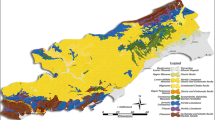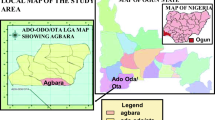Abstract
The current work reports the activity concentrations of several natural radionuclides (226Ra, 232Th, and 40K) in Khak-Sefid area of Ramsar, Iran. An evaluation of total effective dose equivalent (TEDE) from exposure to high-level natural radiations is also presented. Soil samples were analyzed using a high-purity germanium detector with 80 % relative efficiency. The TEDE was calculated on a land area of 40,000 m2 with 1.5-m thickness of contaminated zone for the member of three critical groups of farmer, construction worker, and resident using Residual Radioactive Material Guidelines (RESRAD) modeling program. It was found that the mean activity concentrations (in Bq/kg) were 23,118 ± 468, 25.8 ± 2.3, and 402.6 ± 16.5 for 226Ra, 232Th, and 40K, respectively. The maximum calculated TEDE during 1,000 years was 107.1 mSv/year at year 90, 92.42 mSv/year at year 88, and 22.09 mSv/year at year 46 for farmer, resident, and construction worker scenarios, respectively. The maximum TEDE in farmer scenario can be reduced to the level below the dose limit of 1 mSv/year which is safe for public health using soil cover with thickness of 50 cm or more on the contaminated zone. According to RESRAD prediction, the TEDE received by individuals for all exposure scenarios considerably exceed the set dose limit, and it is mainly due to 226Ra.







Similar content being viewed by others
References
Aghamiri, S. M., Ghorbani, Z., Darafshen, A., Torabzadeh, H., Fathivand, A. A., Minuchehr, A., et al. (2006). 226Ra concentration in the teeth of habitants of areas with high level of natural radioactivity in Ramsar. Journal of Environmental Radioactivity. doi:10.1016/j.jenvrad.2006.05.008.
Amiri, M., Abdi, R., & Shabestani Monfared, A. (2011). Estimation of external natural background gamma ray doses to the population of Caspian coastal provinces in north of Iran. Iranian Journal of Radiation Research, 9(3), 183–186.
Azlina, M. J., Ismail, B., Samudi Yasir, M., Sakuma, S. H., & Khairuddin, M. K. (2003). Radiological impact assessment of radioactive minerals of amang and ilmenite on future landuse using RESRAD computer code. Applied Radiation and Isotopes. doi:10.1016/S0969-8043(02)00347-0.
Bavarnegin, E., Vahabi-Moghaddam, M., Babakhani, A., & Fathabadi, N. (2012). Analytical study of radionuclide concentration and radon exhalation rate in market available building materials of Ramsar. Journal of Theoretical and Applied Physics. doi:10.1186/2251-7235-6-5.
Bavarnegin, E., Vahabi-Moghaddam, M., & Fathabadi, N. (2013). Natural radionuclide and radiological assessment of building materials in high background radiation areas of Ramsar, Iran. Journal of Medical Physics. doi:10.4103/0971-6203.111325.
Borzoueisileh, S., Shabestani Monfared, A., Abediankenari, S., Mostafazadeh, A., & Khosravifarsani, M. (2013). The effects of residence duration in high background radiation areas on immune surveillance. Journal of Natural Science, Biology and Medicine. doi:10.4103/0976-9668.107295.
Burt, R. (2009). Soil survey field and laboratory methods manual. Soil Survey Investigations Report No. 51. National Soil Survey Center, Natural Resources Conservation Service, U.S. Department of Agriculture Lincoln, Nebraska. Available at: ftp://ftp-fc.sc.egov.usda.gov/NSSC/Lab_References/SSIR_51.pdf. Accessed January 2013.
Butt, T. E., Lockley, E., & Oduyemi, K. O. K. (2008). Risk assessment of landfill disposal sites—state of the art. Waste Management. doi:10.1016/j.wasman.2007.05.012.
D’Arienzo, M., Borgognoni, F., Coniglio, A., Daniele, A., Sandri, S., & Tosti, S. (2010). Radiation dose due to tritium release from the ITER neutral beam injector. Fusion Engineering and Design. doi:10.1016/j.fusengdes.2010.09.012.
Dołhańczuk-Śródka, A. (2012). Estimation of external gamma radiation dose in the area of Bory Stobrawskie forests. Environmental Monitoring and Assessment. doi:10.1007/s10661-011-2380-4.
Durante, M., & Pugliese, M. (2003). Depleted uranium residual radiological risk assessment for Kosovo sites. Journal of Environmental Radioactivity, 64, 237–245.
EPA, U.S. Environmental protection agency. (2002). Supplemental guidance for developing soil screening levels for superfund sites. Available at: http://www.epa.gov/oerrpage/superfund/health/conmedia/soil/pdfs/ssg_main.pd. Accessed March 2012
Ferenbaugh, J. K., Fresquez, P. R., Ebinger, M. H., Gonzales, G. J., & Jordan, P. A. (2002). Radionuclides in soil and water near a low-level disposal site and potential ecological and human health impacts. Environmental Monitoring and Assessment, 74(3), 243–254.
Ghiassi-nejad, M., Mortazavi, S. M. J., Cameron, J. R., Niroomand-rad, A., & Karam, P. A. (2002). Very high background radiation areas of Ramsar, Iran: preliminary biological studies. Health Physics, 82, 87–93.
Ghiassi-Nejad, M., Beitollahi, M. M., & Reza-Nejad, F. (2003). Exposure to 226Ra from consumption of vegetables in the high level natural radiation area of Ramsar-Iran. Journal of Environmental Radioactivity, 66(3), 215–225.
Ghiassi-Nejad, M., Zakeri, F., Assaei, R. G., & Kariminia, A. (2004). Long-term immune and cytogenetic effects of high level natural radiation on Ramsar inhabitants in Iran. Journal of Environmental Radioactivity. doi:10.1016/j.jenvrad.2003.12.001.
Giannardi, C., & Dominici, D. (2003). Military use of depleted uranium: assessment of prolonged population exposure. Journal of Environmental Radioactivity, 64, 227–236.
Gilmore, G. R. (2008). Practical gamma-ray spectrometry (2nd ed.). Chichester: Wiley.
IAEA. (1987). Preparation of gamma-ray spectrometry reference materials RGU-1, RGTh-1 and RGK-1 report-IAEA/RL/148. Vienna: Austria.
IAEA-TECDOC-1415. (2004). Soil sampling for environmental contaminants. International Atomic Energy Agency, Vienna. Available at: http://www-pub.iaea.org/MTCD/Publications/PDF/te_1415_web.pdf. Accessed February 2011.
ICRP. (1990). Recommendations of the International Commission on Radiological Protection. ICRP publication 60, Annals of the ICRP. New York: Pergamon.
ICRP. (1993). Protection against radon-222 at home and at work. ICRP publication 65, Annals of the ICRP. New York: Pergamon.
ICRP. (1995). Age-dependent doses to the members of the public from intake of radionuclides: part 5. Compilation of ingestion and inhalation coefficients. ICRP publication 72, Annals of the ICRP. New York: Pergamon.
Kamboj, S., Cheng, J. J., Yu, C., Domotor, S., & Wallo, A. (2009). Modeling of the EMRAS urban working group hypothetical scenario using the RESRAD-RDD methodology. Journal of Environmental Radioactivity. doi:10.1016/j.jenvrad.2009.03.018.
Kleinschmidt, R., & Akber, R. (2008). Naturally occurring radionuclides in materials derived from urban water treatment plants in southeast Queensland, Australia. Journal of Environmental Radioactivity. doi:10.1016/j.jenvrad.2007.09.001.
Mehra, R., Singh, S., Singh, K., & Sonkawade, R. (2007). 226Ra, 232Th and 40K analysis in soil samples from some areas of Malwa region, Punjab, India using gamma ray spectrometry. Environmental Monitoring and Assessment. doi:10.1007/s10661-007-9624-3.
Mortazavi, S. M. J., & Mozdarani, H. (2013). Non-linear phenomena in biological findings of the residents of high background radiation areas of Ramsar. International Journal of Radiation Research, 11(1), 3–9.
Mortazavi, S. M. J., Ghiassi-Nejad, M., & Rezaiean, M. (2005). Cancer risk due to exposure to high levels of natural radon in the inhabitants of Ramsar, Iran. International Congress Series. doi:10.1016/j.ics.2004.12.012.
Mosavi-Jarrahi, A., Mohagheghi, M., Akiba, S., Yazdizadeh, B., Motamedi, N., & Shabestani Monfared, A. (2005). Mortality and morbidity from cancer in the population exposed to high level of natural radiation area in Ramsar, Iran. International Congress Series, 1276, 106–109.
Rahn, R. O., & Upton, A. C. (2007). Radiological risk assessment. In M. G. Robson & W. A. Toscano (Eds.), Risk assessment for environmental health (pp. 239–283). New York: Wiley.
Saghirzadeh, M., Gharaati, M. R., Mohammadi, S., & Ghiassi-Nejad, M. (2008). Evaluation of DNA damage in the root cells of Allium cepa seeds growing in soil of high background radiation areas of Ramsar-Iran. Journal of Environmental Radioactivity. doi:10.1016/j.jenvrad.2008.03.013.
SAIC, Science Applications International Corporation. (2002).White paper: using RESRAD in a CERCLA radiological risk assessment. Buffalo, New York. Available at: http://pbadupws.nrc.gov/docs/ML0726/ML072690228.pdf. Accessed November 2011.
Samavat, H., Seaward, M. R. D., Aghamiri, S. M. R., & Reza-Nejad, F. (2006). Radionuclide concentrations in the diet of residents in a high level natural radiation area in Iran. Radiation and Environmental Biophysics. doi:10.1007/s00411-006-0066-z.
Satvatmanesh, D., Siavoshi, F., Beitollahi, M. M., Amidi, J., & Fallahian, N. (2003). Biosorption of 226Ra in high level natural radiation areas of Ramsar, Iran. Journal of Radioanalytical and Nuclear Chemistry, 258, 483–486.
Sohrabi, M., & Babapouran, M. (2005). New public dose assessment from internal and external exposures in low- and elevated-level natural radiation areas of Ramsar, Iran. International Congress Series. doi:10.1016/j.ics.2004.11.102.
Sohrabi, M., & Esmaili, A. R. (2002). New public dose assessment of elevated natural radiation areas of Ramsar (IRAN) for epidemiological studies. International Congress Series, 1225, 15–24.
Sweeck, L., Kanyár, B., Krajewski, P., Kryshev, A., Lietava, P., Nenyei, A., et al. (2005). Model testing for the remediation assessment of a radium contaminated site in Olen, Belgium. Journal of Environmental Radioactivity. doi:10.1016/j.jenvrad.2003.02.002.
UNSCEAR. (2000). Sources and effects of ionizing radiation. United Nations Scientific Committee on the Effects of Atomic Radiation. Annex A, B&E, United Nations, New York. Available at: http://www.unscear.org/unscear/publications/2000_1.html. Accessed April 2012.
Wang, G., Su, M.-Y., Chen, Y.-H., Lin, F.-F., Luo, D., & Gao, S.-F. (2006). Transfer characteristics of cadmium and lead from soil to the edible parts of six vegetable species in southeastern China. Environmental Pollution. doi:10.1016/j.envpol.2005.12.023.
Whicker, F. W., & Rood, A. S. (2008). Terrestrial food chain pathways: Concepts and models. In J. E. Till & H. A. Grogan (Eds.), Radiological risk assessment and environmental analysis (pp. 260–334). New York: Oxford University Press.
Yu, C., Loureiro, C., Cheng, J. J., Jones, L. G., Wang, Y. Y., Chia, Y. P., et al. (1993). Data collection handbook to support modeling of the impacts of radioactive material in soil. ANL/EAIS-8. Argonne National Laboratory, Argonne, IL. Available at: http://web.ead.anl.gov/resrad/documents. Accessed November 2011.
Yu, C., Zielen, A. J., Cheng, J. J., LePoire, D. J., Gnanapragasam, E., Kamboj, S., et al. (2001). User's manual for RESRAD, version 6. ANL/EAD-4. Argonne National Laboratory, Argonne, IL. Available at: http://web.ead.anl.gov/resrad/documents. Accessed November 2011.
Author information
Authors and Affiliations
Corresponding author
Rights and permissions
About this article
Cite this article
Ziajahromi, S., Khanizadeh, M. & Nejadkoorki, F. Total effective dose equivalent assessment after exposure to high-level natural radiation using the RESRAD code. Environ Monit Assess 186, 1907–1915 (2014). https://doi.org/10.1007/s10661-013-3504-9
Received:
Accepted:
Published:
Issue Date:
DOI: https://doi.org/10.1007/s10661-013-3504-9




